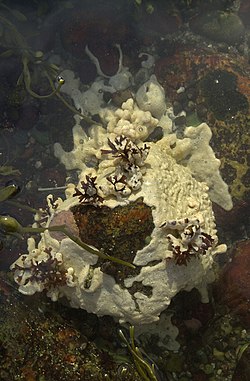Didemnum: Difference between revisions
Appearance
Content deleted Content added
Samuelsenwd (talk | contribs) updated info |
Jboltonnal (talk | contribs) |
||
| Line 43: | Line 43: | ||
* [http://woodshole.er.usgs.gov/project-pages/stellwagen/didemnum/index.htm Woods Hole] |
* [http://woodshole.er.usgs.gov/project-pages/stellwagen/didemnum/index.htm Woods Hole] |
||
* (USGS) National Geologic Studies of [[Benthic]] [[Habitats]], Northeastern United States has a Marine Nuisance Species page dedicated to this genus |
* (USGS) National Geologic Studies of [[Benthic]] [[Habitats]], Northeastern United States has a Marine Nuisance Species page dedicated to this genus |
||
==External links== |
|||
* [http://www.invasivespeciesinfo.gov/aquatics/seasquirt.shtml Species Profile- Sea Squirt (''Didemnum vexillum'')], National Invasive Species Information Center, [[United States National Agricultural Library]]. Lists general information and resources for Sea Squirt. |
|||
[[Category:Ascidiacea]] |
[[Category:Ascidiacea]] |
||
Revision as of 18:39, 16 February 2011
| Didemnum | |
|---|---|

| |
| Tunicate colonies of Didemnum | |
| Scientific classification | |
| Kingdom: | |
| Phylum: | |
| Subphylum: | |
| Class: | |
| Order: | |
| Family: | |
| Genus: | Didemnum Savigny, 1816
|
Didemnum is a genus of tunicates in the family Didemnidae. Some varieties of didemnum can be characterized as invasive species. This is particularly an issue off the east coast of the United States, where in early 2006 didemnum were estimated to inhabit more than 175 square kilometers of this undersea region. Other areas where didemnum are seen as invasive include Canada, New Zealand and the Netherlands.<"Invasion der Pfankuchen" Der Spiegel, 1/2006, p. 102/>
Didemnum vexillum turned up on coast of state of Washington in 2009 and showing up in Coos Bay and Winchester Bay, Oregon as of 13 May 2010. Invasive marine species hits Oregon coast.
Species
- Didemnum albidum (Verrill, 1871)
- Didemnum amethysteum (Van Name, 1902)
- Didemnum asperum (Milne-Edwards, 1841)
- Didemnum biglans (Sluiter, 1906)
- Didemnum candidum Savigny, 1816
- Didemnum carnulentum Ritter and Forsyth, 1917
- Didemnum chilense Arnbaeck, 1929
- Didemnum coriaceum (Von Drasche, 1883)
- Didemnum fulgens (Milne-Edwards, 1841)
- Didemnum galacteum Lotufo & Dias, 2007
- Didemnum gelatinosum
- Didemnum helgolandicum
- Didemnum lahillei Hartmeyer, 1909
- Didemnum maculosum (Milne-Edwards, 1841)
- Didemnum santaelenae Van Name, 1945
- Didemnum studeri Hartmeyer, 1911
- Didemnum tenue (Herdman, 1886)
- Didemnum vanderhorsti Van Name, 1924
- Didemnum vexillum Kott, 2002

References
- Woods Hole
- (USGS) National Geologic Studies of Benthic Habitats, Northeastern United States has a Marine Nuisance Species page dedicated to this genus
External links
- Species Profile- Sea Squirt (Didemnum vexillum), National Invasive Species Information Center, United States National Agricultural Library. Lists general information and resources for Sea Squirt.
